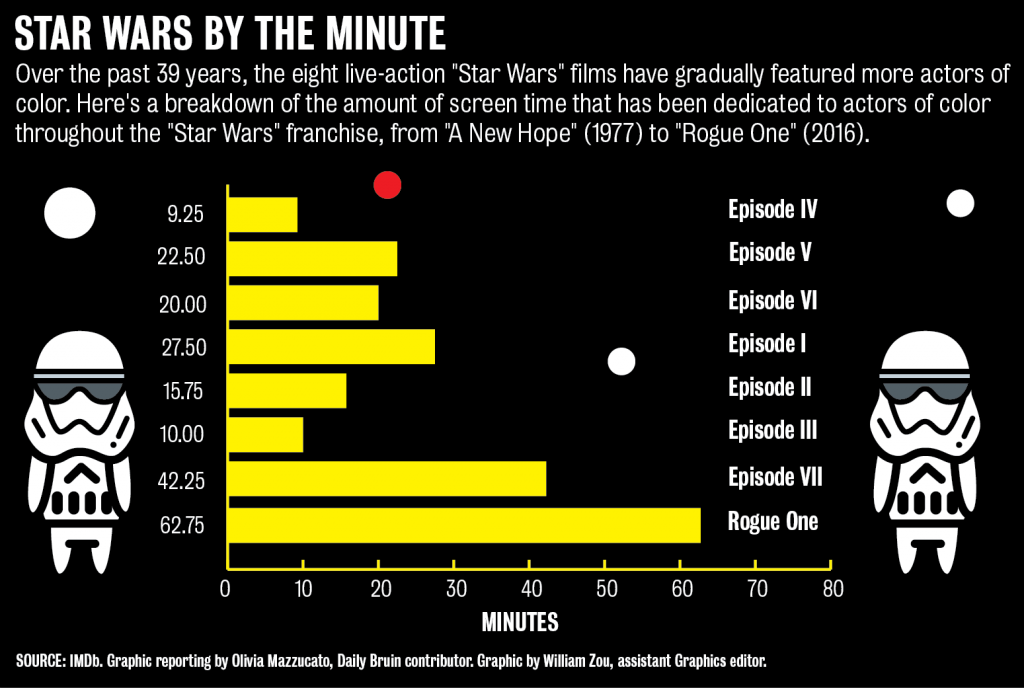Diversity in film and television came into the spotlight in 2016 with #OscarsSoWhite. A USC study in 2016 found only about one quarter of speaking characters belonged to non-white racial/ethnic groups. In “Reel Representation,” columnist Olivia Mazzucato discusses different issues of race and representation in media as they relate to new movies and TV shows.
“Star Wars: Episode VII – The Force Awakens” is full of jaw-dropping action sequences and nostalgic characters. But the moment that meant the most to me flew a little under the radar.
The film leads up to a climactic X-wing fighter battle as different Resistance pilots work together to destroy Starkiller Base. Some criticized the sequence for being a retread of “Star Wars: Episode IV – A New Hope,” but I spotted one glaring difference.
In the midst of all the fighting was a female Asian X-wing pilot.
I was speechless. I looked around the theater and checked to see if anyone else had noticed, if anyone else was feeling the same sense of inexplicable euphoria.
The pilot’s name is Jessika “Testor” Pava (Jessica Henwick). She has a little more than 10 seconds of screen time and only a handful of lines. But to me, she is one of the most important characters in “The Force Awakens.” For a short moment, I became a kid again and I believed that I, too, could be an X-wing pilot.
[Related: Movie Review: ‘Rogue One: A Star Wars Story‘]
The revived “Star Wars” universe is markedly more diverse than that of the originals and prequels. The original trilogy features one character of color, Lando Calrissian (Billy Dee Williams), and one voice actor of color, James Earl Jones, as the voice of Darth Vader – though Vader is eventually revealed to be white in “Star Wars: Episode VI – Return of the Jedi” and the subsequent prequels. The prequels feature more people of color, though they are mostly relegated to roles as ancillary characters.
The mere presence of actors of color onscreen is groundbreaking – it is rare that a movie character is a person of color.
A 2016 USC study sampled 109 films above a certain domestic box office performance threshold and found 18 percent of films had no black characters and 50 percent of films had no Asian characters.

“The Force Awakens” features Finn, a black Stormtrooper, as one of the protagonists, and December’s “Rogue One: A Star Wars Story” stars numerous actors of color, including Mexican Diego Luna, British-Pakistani Riz Ahmed, Hong Kong’s Donnie Yen and Chinese Jiang Wen.
On Jan. 2, a story went viral about a girl who took her Mexican father to see “Rogue One.” Within minutes, he noticed the presence of Luna playing Cassian Andor, and even after they left the theater, he continued to talk about the fact that a person of color with a heavy Mexican accent had been a main character in the film.
If this is the effect that representation had on a grown man, I can only imagine how young children felt, seeing someone who looked like them in “Star Wars.”
When I saw “Rogue One,” I felt a mixture of gratification and hope. I was proud that a franchise I loved valued characters of color and had no qualms about portraying a multiracial team of heroes. “Rogue One” was proof for me that the diversity of “Star Wars” went deeper than just having a few visible characters of color in one film. If “Star Wars” continues to cast people of color, maybe other films and franchises will follow suit.
Equating Cassian Andor or Finn with the likes of Luke Skywalker reinforces the idea that people of color matter, that they are equally influential and relevant.
But even beyond the action and the main story, the characters that inhabit the rest of the world are just as – if not more – diverse than the main cast.
In “Rogue One,” when the rebels meet to discuss a final course of action, two of the senators are played by black British actress Sharon Duncan-Brewster and Swedish-Assyrian actor Fares Fares.
The narrative had no specific reason for the characters to be played by people of color. The actors’ races are not tied to the identities of their characters. But there was no reason for the characters to be inherently white either. In a time when white is often the default, there is something inherently powerful about a character who is a person of color for no apparent reason. It normalizes diversity and the idea that the world we inhabit is not monochrome.
The newer “Star Wars” films are refreshing because they take place in a universe that doesn’t focus on race, where people of color are simply allowed to be people whose racial identities are not focal points, nor are they integral to the plot. In the “Star Wars” universe, a black Stormtrooper is just another Stormtrooper.
[Throwback: Movie Review: ‘Star Wars: The Force Awakens‘]
Diversity in all forms and films is important. I don’t want Hollywood to stop making biopics about people of color or films that dive into racial issues. But I do want Hollywood to realize it can cast a person of color to play any character. Representation doesn’t need a specific narrative or character type; it just needs a film that realizes people of color are just people.
I look forward to the day when a column like this will be totally irrelevant, when it will be unnecessary to point out the diversity in “Star Wars” because it will be completely normal for movies to reflect the world in which we live.
Until then, I will continue to celebrate films like “The Force Awakens” and “Rogue One,” if only so that boys and girls of all backgrounds can look up at the screen and feel the same swell of pride that I felt when Jessika Pava soared across it.
